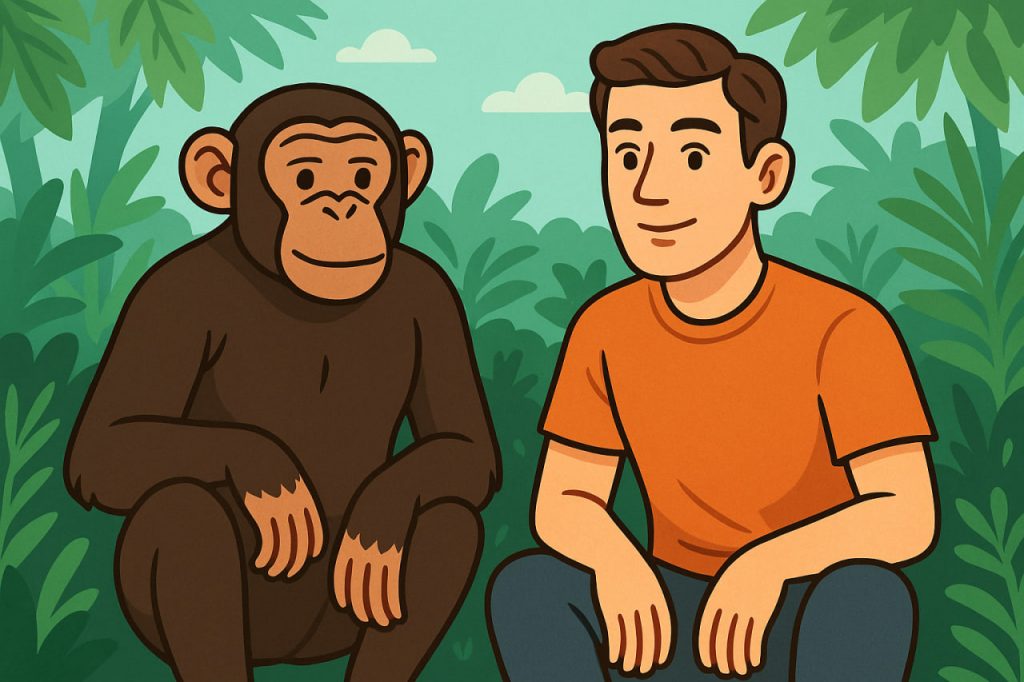Monkeys and humans share a fascinating bond that stretches back millions of years. Although humans have evolved into a unique species with advanced intelligence and culture, the roots of our anatomy, behavior, and even emotions are deeply connected to our primate relatives. Studying these similarities not only helps us understand where we come from but also reveals how evolution has shaped the way we think, move, and live today.
Evolutionary Relationship
According to evolutionary biology, humans and modern monkeys share a common ancestor that lived around 25–30 million years ago. Over time, different primate groups evolved along separate paths — some leading to Old World monkeys (like macaques and baboons), others to apes (like chimpanzees and gorillas), and one line eventually giving rise to Homo sapiens.
This shared ancestry explains the genetic and structural similarities we still see today. For example, humans and chimpanzees share about 98–99% of their DNA, making them our closest living relatives.
Physical Similarities
The most obvious resemblance between humans and monkeys lies in body structure.
- Skeletal structure: Both have a similar arrangement of bones, including five fingers and toes, opposable thumbs, and flexible shoulder joints — allowing precise movement and tool use.
- Facial features: Many monkeys show expressive eyes, forward-facing vision, and similar dental patterns.
- Brain structure: Both have large, complex brains relative to body size, capable of memory, planning, and communication.
- Internal organs: The digestive, circulatory, and nervous systems are almost identical in basic design.
These similarities make monkeys valuable models for medical and neurological research — though modern ethics demand minimizing animal testing.
Behavioral and Emotional Parallels
Humans and monkeys not only look alike in some ways but also act and feel in remarkably similar manners.
- Social structure: Both live in groups with clear hierarchies and social bonds. Grooming in monkeys serves a similar purpose to human friendship and conversation.
- Communication: Monkeys use gestures, facial expressions, and sounds to express emotions — much like human nonverbal communication.
- Learning and imitation: Young monkeys learn by observing elders, just as human children mimic adults.
- Emotions: Fear, joy, affection, and grief have all been observed in primates. For instance, chimpanzees mourn their dead and comfort one another — behaviors once thought to be uniquely human.
Cognitive and Tool-Using Abilities
Some monkeys and apes demonstrate surprising intelligence. They can use sticks to extract insects, stones to crack nuts, and leaves as makeshift sponges. These behaviors show the early roots of technological development — the foundation of human innovation.
Research has shown that certain species, like capuchin monkeys and chimpanzees, can understand cause and effect, recognize themselves in mirrors, and even solve simple puzzles — all signs of self-awareness and problem-solving ability.
Genetic and Biological Similarities
DNA comparisons reveal that humans and monkeys share not only most of their genes but also similar biological functions. For example:
- Both species can contract similar diseases, such as influenza and malaria.
- Hormonal systems, including stress and reproduction hormones, operate nearly identically.
- Blood proteins and immune responses show close correspondence.
These parallels have allowed scientists to study human physiology and disease evolution by observing primates.
The Key Differences
Despite the closeness, several key differences distinguish humans from monkeys:
- Bipedalism: Humans walk upright, while monkeys usually walk on all fours or swing using their arms.
- Brain size: The human brain is three times larger, supporting advanced reasoning, language, and creativity.
- Speech: Humans possess a uniquely structured larynx that enables complex speech.
- Culture and technology: Humans build civilizations, record history, and consciously transform their environment.
These distinctions emerged through millions of years of adaptation, turning early hominins into the only species capable of abstract thought, moral reflection, and large-scale cooperation.
Why the Similarities Matter
Recognizing our biological kinship with monkeys reminds us that humanity is part of nature, not separate from it. This understanding fosters respect for wildlife, encourages conservation of primate habitats, and deepens our sense of connection to the living world.
Moreover, studying monkeys helps scientists uncover insights into neurology, psychology, and social behavior, including human mental health and the development of language.
Interesting Facts
- Humans share about 98.8% of their DNA with chimpanzees.
- Some macaques wash food in water — an example of cultural behavior passed between generations.
- Bonobos resolve conflicts through social bonding and empathy, much like humans.
- The fossil record shows that the last common ancestor between humans and apes lived around 6–8 million years ago.
P.S. A person can be the most ferocious animal, burning their own kind in gas chambers, or they can be a doctor who restores the health of thousands in their lifetime. The only question is our choice: listen to soul inside us and live by higher ideals, or to be seduced by the images and thoughts that flood our head every second. The choice is ours…
Glossary
- Common ancestor — a species from which two or more later species evolved.
- Bipedalism — walking on two legs.
- Genetic similarity — the percentage of shared DNA sequences between two species.
- Hominins — a group that includes modern humans and their extinct ancestors.
- Social hierarchy — the organization of individuals in a group according to status or authority.


